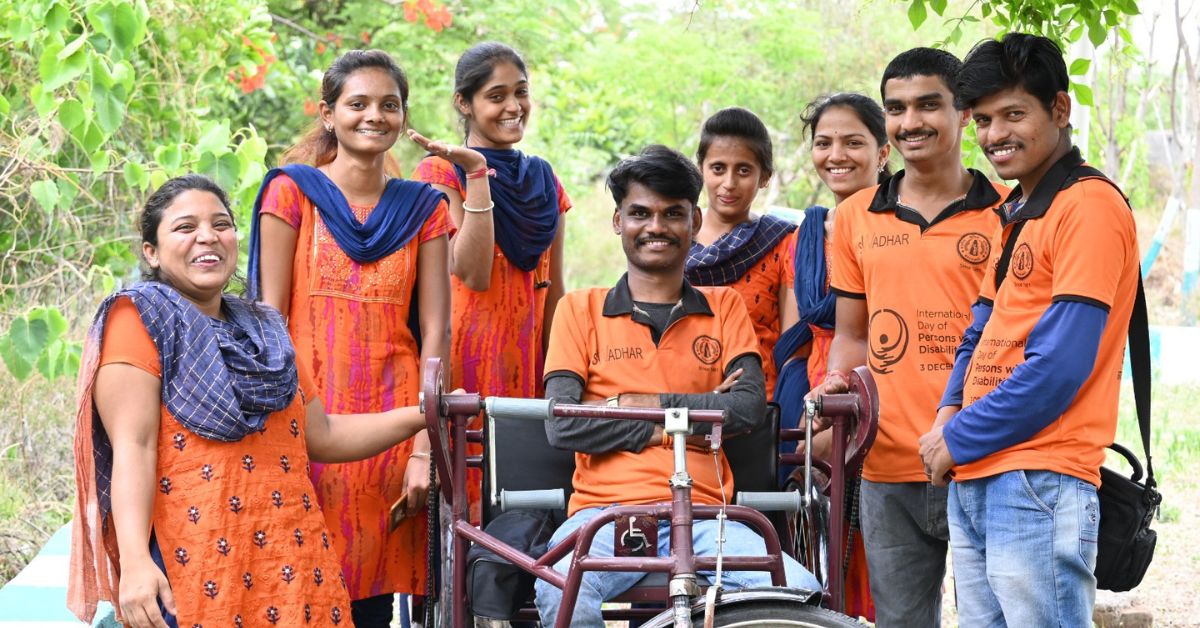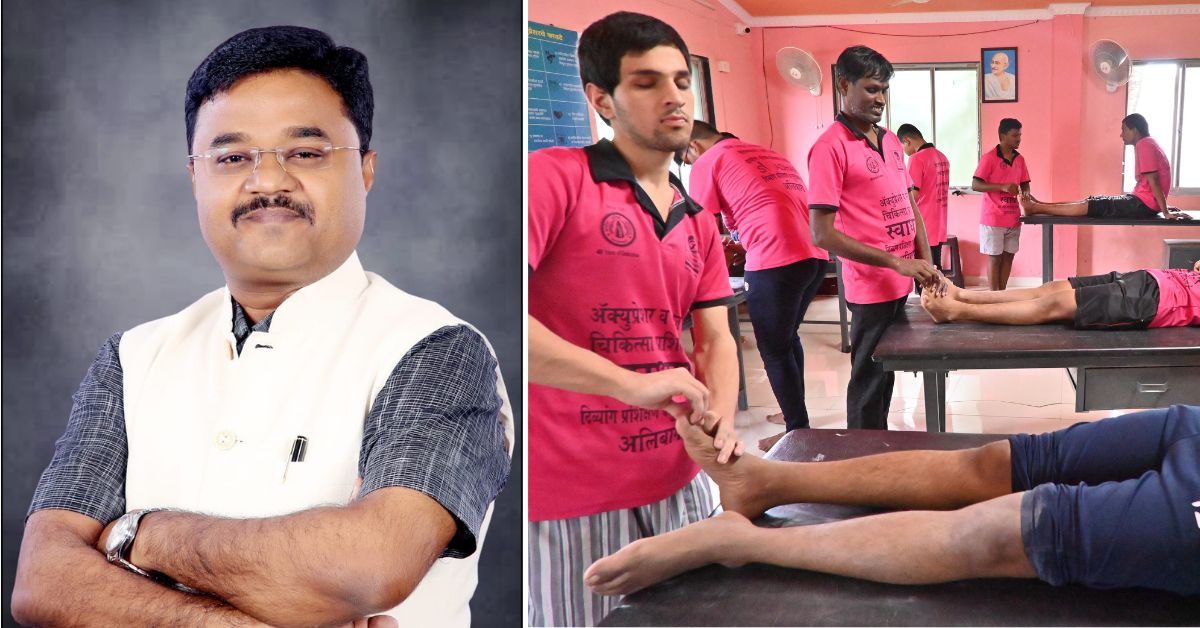
[ad_1]
Set off warning: This story has mentions of suicide.
When Harishchandra Sude, the founding father of the non-profit Grameen Shramik Pratishthan, was requested about his childhood aspirations, his response was moderately peculiar and profound.
He remembers how throughout an Independence Day celebration, the place every pupil was required to share their desires and aspirations, he had stood up and promptly declared, “I wish to create a world the place everybody helps one another; a world envisioned by Gandhi himself!”
Whereas many might have smiled at younger Harishchandra’s aspirations, little did they know that this decided boy would go on to empower over 1,000 folks with visible impairment and different disabilities — granting them autonomy.
For the previous 43 years, by his organisation, he has been offering them with coaching in acupressure, loom operation, and graphic designing in digital media.
The journey to independence
Harishchandra is the primary college graduate, not solely in his household but in addition in his complete village. Regardless of being a younger man with extraordinary desires, societal expectations nudged him in the direction of looking for employment within the bustling “massive cities”.
Recalling these pivotal moments, he shares, “If you’re the primary in your loved ones or village to efficiently graduate from college, all eyes are on you. My father and the villagers anticipated that I’d safe a job and contribute financially to the family.”
Nonetheless, Harishchandra’s aspirations diverged from standard expectations. He explains, “From a really younger age, I realised that sure segments of society obtain little to no help. They’re typically marginalised and compelled to depend upon others. Securing a job was by no means my intention; my aim was to help the neglected sections of society.”
Now fondly known as the ‘Angel for the disabled’, Harishchandra’s childhood was a far cry from being blissful or safe. “I used to be solely a younger little one of 5 years after I caught smallpox. As a result of illness, I misplaced imaginative and prescient in one among my eyes and developed numerous scars on my face,” he says.
Whereas the younger boy survived the illness, he turned an outsider to different youngsters within the village. “The scars on my face and the lack of imaginative and prescient made me a ‘troublesome little one’. My mom, who was at all times fearful about me, handed away the identical yr,” he says.

The house was left in a state of disarray after his mom handed away. “My father and my brothers used to go to the fields and work. My sister, who was no more than 12 years outdated, was additionally married off. There was nobody to care for me,” he says.
He continues, “I used to be despatched to dwell with my grandmother and that shift, in some ways, gave me the proper set of alternatives to do what I at all times wished to do.”
He acquired admitted into a university within the Latur district however couldn’t afford the charges. “The principal on the time was a person of comparable beliefs as mine. I used to inform him how I wished to work for society. He secured a job as an errand boy for me within the school itself which helped me pay the charges,” he provides.
“It was his imaginative and prescient that helped me join with Baba Amte, the legendary social employee and activist who labored with folks affected by leprosy,” he says, “My principal despatched me to him, looking for assist for my imaginative and prescient. I used to go to his addresses and lectures to grasp how one may also help different folks on a macro degree.”
‘Was known as a idiot behind my again’
After finishing his commencement, he moved again to his village in Latur district to assist underprivileged folks acquire employment.
“I used to be getting my arms soiled on the sphere however nobody might perceive what I used to be doing. I used to be the primary one to graduate, they anticipated me to do some job. They may not perceive why I’d come again to the village. They thought of me a failure,” he says.
Demotivated by all of the feedback, he moved to Pune. “I used to be disheartened and lacked course in my work. I moved to Pune looking for assist from different social employees,” he says.
Baba Amte then steered that he ought to first turn out to be financially impartial and turn out to be a trainer. “There was a college for the blind in entrance of my school, and as soon as I accomplished my diploma, I began to show the children there. It was there that I learnt that the children get moved from one organisation to a different continually, both resulting from monetary difficulties or lack of infrastructure. This hampered their progress and gave me the concept to do one thing to assist folks with visible impairments,” he shares.
With this concept in thoughts of making a “Swadhar Kendra” in rural areas and villages, he left the town once more. “The concept was that I wished these kids to get coaching and provides them work alternatives,” he says.
When he determined to depart the college and transfer again to the village, a pupil of his who additionally labored for him, determined to maneuver too. “He might sing and dance effectively, and I used his artwork to seize the eye of the villagers. The sarpanch took us to the governor to get us a chunk of land to remain and work on,” he says.
This was the inspiration stone of what later turned Grameen Shramik Pratishthan.
“We acquired a 40×40 sq ft piece of land and we constructed a ‘jhopadi’ (hut). We might make bedsheets and blankets within the hut after which promote them. Folks had been intrigued as to how a partially-impaired or blind particular person might do such a factor,” he says.
Phrase began spreading. Quickly, increasingly visually impaired folks began to get in contact with him. “I might lastly see my dream shaping up. Quickly, we had been dwelling with many extra visually impaired folks,” he says.

However all of the actions got here to a halt when the realm was hit by heavy rains and an enormous flood; every thing was washed away. “There have been too many individuals staying with me. We had misplaced all of the huts that we had constructed; I had misplaced all hope. It was the individuals who inspired me saying that dangerous instances at all times go away,” he says.
Harishchandra went again to his native village Dangewadi and requested his father for assist. “We had some ancestral land and I requested my father for my share. Though I acquired numerous retaliation from him as he believed that this was a waste of time, he gave me three-acre land,” he shares.
Harishchandra offered off that land and acquired new land in Village Budhoda within the Ausa block of Latur district, which now holds the Grameen Shramik Pratishthan.
On preventing the society and his household to start out the organisation, Harishchandra says, “I used to be the primary particular person to graduate from school. I might have simply caught to a job and ‘given again’ to my household, however I wished to make use of my training to present again to society.”
Basis of the NGO & how one can assist
Harishchandra has spent many years of his life caring for the underserved. His son Prashant Sude is following in his father’s footsteps too.
“My father nonetheless works and stays each day, however I’ve now taken over the operations of the organisation. There are a couple of ranges of interventions that we do to assist folks with disabilities,” he says.
The NGO works to assist folks with disabilities by giving them coaching in several areas to assist them turn out to be impartial.
“Beneath our Swadhar Scheme, what we initially did was prepare them in recycling outdated sarees into mats. The disposal of outdated sarees is a major situation, contributing to environmental hurt. At our hand-me-down centre, we recycle these sarees into mats, offering a sustainable answer to this downside. In doing so, they not solely earn a livelihood but in addition contribute to addressing the environmental challenges related to non-biodegradable waste,” he provides.
Nonetheless, with altering instances, Prashant realised that this coaching may not be viable after a couple of years.
“We’ve got to maintain altering with time. I realised that this may not be a really financially good occupation sooner or later. In 2010, we began giving acupressure and therapeutic massage coaching to visually impaired folks. Therapeutic massage is a superb livelihood exercise for visually challenged people as a result of they possess sharp sensory skills,” he says.
The coaching strategies are easy but efficient, permitting each less-educated and well-educated people to study acupressure therapeutic massage systematically and scientifically. “Via our course, college students study anatomy, physiology, and varied therapeutic massage strategies virtually. Consequently, they turn out to be specialists within the discipline of acupressure therapeutic massage strategies,” he provides.
As soon as the people are educated, they’ll return to their native village and practise there or keep on the centre and earn at the least Rs 500 per therapeutic massage.
The NGO additionally helps individuals with disabilities get married and begin a house. “The best way society appears to be like at folks with disabilities, particularly ladies, in villages and small cities, is regarding. If a person desires to get married to somebody, we take their duty and assist them with all of the preparations,” he says, including that they’ve facilitated over 50 marriages thus far.

Vidnyan Masure, a visually impaired particular person from Nanded, skilled prejudice all her life. She shares, “I used to be very depressed and had low vanity. I even tried to finish my life. Nonetheless, becoming a member of GSP modified my life fully. I registered to study therapeutic massage remedy and I’m now absolutely impartial. I work in a naturopathy centre in my village and likewise educate this artwork to younger visually impaired ladies.” The 37-year-old is now fortunately married and feels a way of dignity and independence.
In 2021, the NGO got here up with one other department of coaching. “We educate them varied digital expertise similar to graphic design, video enhancing, reel making, and social media administration. These expertise are notably appropriate for them as a result of whereas these with locomotor disabilities might have restricted motion, they preserve their power and focus it extra on artistic considering.”
The four-month course locations important emphasis on sensible expertise, the place college students study to make use of software program like Canva, CorelDraw, and different instruments to create designs, edit pictures, and produce digital content material.
“Over the previous two years, we now have educated 80 visually challenged people in these digital expertise, offering them with alternatives for significant employment and empowerment. They use the labs on the NGO to practise their ability and do their work with out having to maneuver lots,” he says.
Whereas Prashant and Harishchandra together with many volunteers have helped a whole lot of individuals, Prashant now needs to develop the mannequin all through Maharashtra.
“The visually impaired in our nation are handled as second-class residents. They’re equally expert if given the proper set of alternatives, however they’re uncared for typically by their very own household. With Swadhaar, we’re aiming to scale back this hole by presenting them with the proper alternatives. We wish to assist them turn out to be impartial, self-sustaining, and dwell the life they deserve,” says Prashant.
Harishchandra and Prashant’s combat to present equal rights to folks with disabilities doesn’t should be theirs alone. You may contribute to their trigger too. Click on right here to do your half.
(Edited by Padmashree Pande and Pranita Bhat)
(All footage credit score: Prashant Sude)
[ad_2]